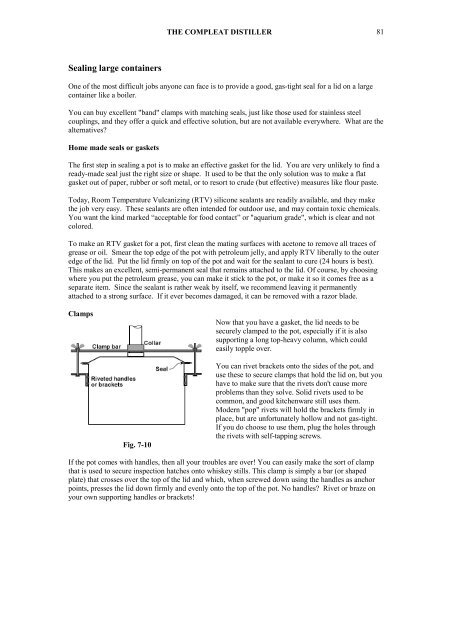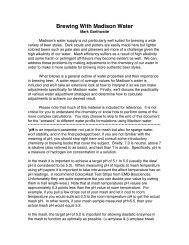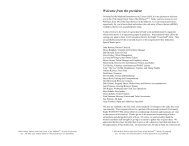The Compleat Distiller
The Compleat Distiller
The Compleat Distiller
Create successful ePaper yourself
Turn your PDF publications into a flip-book with our unique Google optimized e-Paper software.
THE COMPLEAT DISTILLER 81<br />
Sealing large containers<br />
One of the most difficult jobs anyone can face is to provide a good, gas-tight seal for a lid on a large<br />
container like a boiler.<br />
You can buy excellent "band" clamps with matching seals, just like those used for stainless steel<br />
couplings, and they offer a quick and effective solution, but are not available everywhere. What are the<br />
alternatives?<br />
Home made seals or gaskets<br />
<strong>The</strong> first step in sealing a pot is to make an effective gasket for the lid. You are very unlikely to find a<br />
ready-made seal just the right size or shape. It used to be that the only solution was to make a flat<br />
gasket out of paper, rubber or soft metal, or to resort to crude (but effective) measures like flour paste.<br />
Today, Room Temperature Vulcanizing (RTV) silicone sealants are readily available, and they make<br />
the job very easy. <strong>The</strong>se sealants are often intended for outdoor use, and may contain toxic chemicals.<br />
You want the kind marked “acceptable for food contact” or "aquarium grade", which is clear and not<br />
colored.<br />
To make an RTV gasket for a pot, first clean the mating surfaces with acetone to remove all traces of<br />
grease or oil. Smear the top edge of the pot with petroleum jelly, and apply RTV liberally to the outer<br />
edge of the lid. Put the lid firmly on top of the pot and wait for the sealant to cure (24 hours is best).<br />
This makes an excellent, semi-permanent seal that remains attached to the lid. Of course, by choosing<br />
where you put the petroleum grease, you can make it stick to the pot, or make it so it comes free as a<br />
separate item. Since the sealant is rather weak by itself, we recommend leaving it permanently<br />
attached to a strong surface. If it ever becomes damaged, it can be removed with a razor blade.<br />
Clamps<br />
Now that you have a gasket, the lid needs to be<br />
securely clamped to the pot, especially if it is also<br />
supporting a long top-heavy column, which could<br />
easily topple over.<br />
Fig. 7-10<br />
You can rivet brackets onto the sides of the pot, and<br />
use these to secure clamps that hold the lid on, but you<br />
have to make sure that the rivets don't cause more<br />
problems than they solve. Solid rivets used to be<br />
common, and good kitchenware still uses them.<br />
Modern "pop" rivets will hold the brackets firmly in<br />
place, but are unfortunately hollow and not gas-tight.<br />
If you do choose to use them, plug the holes through<br />
the rivets with self-tapping screws.<br />
If the pot comes with handles, then all your troubles are over! You can easily make the sort of clamp<br />
that is used to secure inspection hatches onto whiskey stills. This clamp is simply a bar (or shaped<br />
plate) that crosses over the top of the lid and which, when screwed down using the handles as anchor<br />
points, presses the lid down firmly and evenly onto the top of the pot. No handles? Rivet or braze on<br />
your own supporting handles or brackets!









